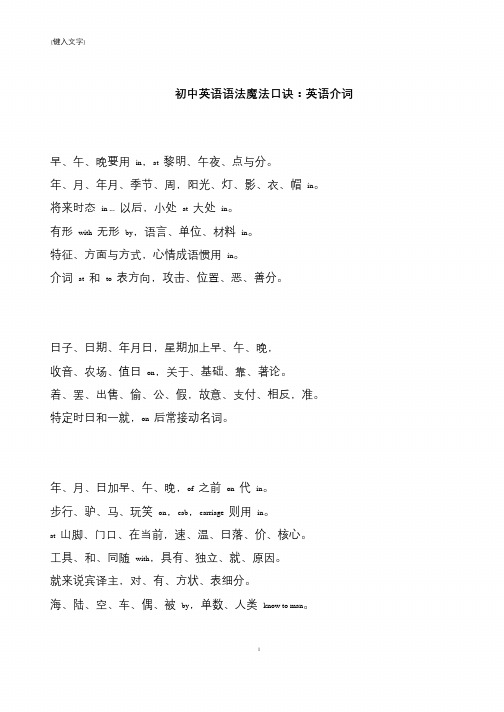初一英语介词口诀大全
【推荐下载】初中英语语法魔法口诀:英语介词

[键入文字]
初中英语语法魔法口诀:英语介词
早、午、晚要用in,at 黎明、午夜、点与分。
年、月、年月、季节、周,阳光、灯、影、衣、帽in。
将来时态in ... 以后,小处at 大处in。
有形with 无形by,语言、单位、材料in。
特征、方面与方式,心情成语惯用in。
介词at 和to 表方向,攻击、位置、恶、善分。
日子、日期、年月日,星期加上早、午、晚,
收音、农场、值日on,关于、基础、靠、著论。
着、罢、出售、偷、公、假,故意、支付、相反,准。
特定时日和一就,on 后常接动名词。
年、月、日加早、午、晚,of 之前on 代in。
步行、驴、马、玩笑on,cab,carriage 则用in。
at 山脚、门口、在当前,速、温、日落、价、核心。
工具、和、同随with,具有、独立、就、原因。
就来说宾译主,对、有、方状、表细分。
海、陆、空、车、偶、被by,单数、人类know to man。
1。
介词用法最全总结顺口溜

介词用法最全总结顺口溜初学英语,介词艰难,用错介词,易引领受烦,多勤练习,介词犹如灵药,掌握用法,表达更加顺畅。
首先介绍,介词表位置, in、on、at,要分清格例。
大楼内在用in,桌上摆着用on,时刻都到用at,这三个绝不搞混。
关系介词to与for, to表目的,到达为止, for则用于目的,表示为了,引导理由。
介词with不可同一,和一起,表手段,介词from表示原点,出处来自,要记精。
介词by表方法,被动动作,介词of说明属于关系,介词about关于题目,介词without无,没有比较。
介词till为直至,介词after过后在你左右,介词before意前,搞清用法不算过。
介词past,未来方式,介词round四舍五入,介词toward向前进,介词against与…对抗。
介词near附近意,介词under下面,介词behind在后面,介词above在上面。
介绍完了基础介词,再来说说复杂位置,介词between在两者间,介词among在众多中。
介词across横穿过,介词through穿过,介词along沿着,介词around围绕。
介词behind在后面,介词beyond在更远,介词beside在旁边,介词inside在里面。
介词outside在外部,介词underneath在下方,介词opposite在对立,介词beneath 在下方。
介绍完了位置介词,再来说说时间关系,介词since自从,介词during在期间。
介词until直至,介词up to达到,介词before之前,介词from自…至今。
介词beyond超越,介词past or over过去,介词by到…为止,介词within在期限。
介绍完了时间介词,希望大家掌握顺口溜,记牢用法,不再困惑,介词用法,与众不同。
英语介词用法口诀

英语介词用法口诀英语介词用法口诀早、午、晚要用in,at黎明、午夜、点与分。
年、月、年月、季节、周,阳光、灯、影、衣、冒in。
将来时态in...以后,小处at大处in。
有形with无形by,语言、单位、材料in。
特征、方面与方式,心情成语惯用in。
介词at和to表方向,攻击、位置、恶、善分。
日子、日期、年月日,星期加上早、午、晚,收音、农场、值日on,关于、基础、靠、著论。
着、罢、出售、偷、公、假,故意、支付、相反,准。
特定时日和"一……就",on后常接动名词。
年、月、日加早、午、晚,of之前on代in。
步行、驴、马、玩笑on,cab,carriage则用in。
at山脚、门口、在当前,速、温、日落、价、核心。
工具、和、同随with,具有、独立、就、原因。
就……来说宾译主,对、有、方状、表细分。
海、陆、空、车、偶、被by,单数、人类know to man。
this、that、tomorrow,yesterday,next、last、one。
接年、月、季、星期、周,介词省略已习惯。
over、under正上下,above、below则不然,若与数量词连用,混合使用亦无关。
beyond超出、无、不能,against靠着,对与反。
besides,except分内外,among之内along沿。
同类比较except,加for异类记心间。
原状because of,、 owing to、 due to表语形容词under后接修、建中,of、from物、化分。
before、after表一点, ago、later表一段。
before能接完成时,ago过去极有限。
since以来during间,since时态多变换。
与之相比beside,除了last but one。
复不定for、找、价、原,对、给、段、去、为、作、赞。
快到、对、向towards,工、学、军、城、北、上、南。
but for否定用虚拟,复合介词待后言。
英语介词用法口诀

介词用法口诀早、午、晚要用in,at黎明、午夜、点与分。
年、月、年月、季节、周,阳光、灯、影、衣、冒in。
将来时态in...以后,小处at大处in。
有形with无形by,语言、单位、材料in。
特征、方面与方式,心情成语惯用in。
介词at和to表方向,攻击、位置、恶、善分。
日子、日期、年月日,星期加上早、午、晚,收音、农场、值日on,关于、基础、靠、著论。
着、罢、出售、偷、公、假,故意、支付、相反,准。
特定时日和"一……就",on后常接动名词。
年、月、日加早、午、晚,of之前on代in。
步行、驴、马、玩笑on,cab,carriage则用in。
at山脚、门口、在当前,速、温、日落、价、核心。
工具、和、同随with,具有、独立、就、原因。
就……来说宾译主,对、有、方状、表细分。
海、陆、空、车、偶、被by,单数、人类know to man。
this、that、tomorrow,yesterday,next、last、one。
接年、月、季、星期、周,介词省略已习惯。
over、under正上下,above、below则不然,若与数量词连用,混合使用亦无关。
’beyond超出、无、不能,against靠着,对与反。
besides,except分内外,among之内along沿。
同类比较except,加for异类记心间。
原状because of,、owing to、due to表语形容词under后接修、建中,of、from物、化分。
before、after表一点, ago、later表一段。
before能接完成时,ago过去极有限。
since以来during间,since时态多变换。
与之相比beside,除了last but one。
复不定for、找、价、原,对、给、段、去、为、作、赞。
快到、对、向towards,工、学、军、城、北、上、南。
but for否定用虚拟,复合介词待后言。
ing型由于鉴,除了除外与包合。
英语介词用法口诀大全

英语介词用法口诀大全
1. In, on, at 常与时间连,时间地点兼备用。
2. From, to, until, till 时间区间好表示,时间段也可大显神通。
3. By, with, from, of 用于表现方式,类别性介词很不错。
4. Of, for, to 用于表目的,句子结构会媲美。
5. About, with, by 用于表同伴,主谓间隔并不遥远。
6. To, with, without 用于表伴随,进行中卖力才是王道。
7. In, to, on, at 用于表示空间,位置与方向齐心助阵。
8. From, between, among 分别表起点、间隔和混杂,还可表格局不一并掌握。
9. Of, in, about 用于表品质,为句子增色不在话下。
10. About, on, with 用于表主题,内容丰富不含糊。
11. In, on, at 用于表时刻,具体程度可考虑。
12. By, of, with 用于表方式,越具体越考验。
常用介词及用法顺口溜

常用介词及用法顺口溜1. “in 在里面,时间季节和地点。
In the room,in summer,in Beijing 真方便!” 比如:I stay in the room all day.(我一整天都待在房间里。
)2. “on 在上面,星期日期和表面。
On Monday,on the table,清楚又明了!” 瞧:The book is on the table.(书在桌子上。
)3. “at 在几点,小地点前也用它。
At six o'clock,at the bus stop,准没错呀!” 像这样:I'll meet you at the bus stop.(我会在公交站见你。
)4. “for 为了啥,一段时间常用它。
For a long time,for you,多实用呀!” 比如说:I waited for you for a long time.(我等了你很长时间。
)5. “of 所属关系要记牢。
The leg of the table,有趣得很!” 就像:The color of the car is red.(车的颜色是红色。
)6. “with 和谁一起用它伴。
With my friends,with a smile,多亲切呀!” 好比:I go to the park with my friends.(我和我的朋友们去公园。
)7. “to 到哪里,方向目标不能忘。
Go to school,run to him,多明确呀!” 像这样:I want to go to the beach.(我想去海滩。
)8. “from 从哪里,来源起始分得清。
From Beijing,from morning,真简单呀!” 例如:He comes from Shanghai.(他来自上海。
)9. “by 靠什么,方式手段用得妙。
By bike,by hand,多形象呀!” 可以说:I go to work by bike.(我骑自行车去上班。
英语介词速记口诀
英语介词速记口诀早、午、晚要用in,at 黎明、午夜、点与分。
年、月、年月、季节、周,阳光、灯、影、衣、帽in。
将来时态in ... 以后,小处at 大处in。
有形with 无形by,语言、单位、材料in。
特征、方面与方式,心情成语惯用in。
介词at 和to 表方向,攻击、位置、恶、善分。
日子、日期、年月日,星期加上早、午、晚,收音、农场、值日on,关于、基础、靠、著论。
特定时日和“一……就”,on 后常接动名词。
年、月、日加早、午、晚,of 之前on 代in。
步行、驴、马、玩笑on,cab,carriage 则用in。
at 山脚、门口、在当前,速、温、日落、价、核心。
工具、和、同随with,具有、独立、就、原因就……来说宾译主,对、有、方状、表细分。
海、陆、空、车、偶、被by,单数、人类know to man。
this、that、tomorrow,yesterday,next、last、one。
接年、月、季、星期、周,介词省略已习惯。
over、under 正上下,above、below 则不然,若与数量词连用,混合使用亦无关。
beyond 超出、无、不能,against 靠着,对与反。
besides,except 分内外,among 之内along 沿。
同类比较except,加for 异类记心间原状because of, owing to,due to 表语形容词。
Under 后接修、建中,of,from 物、化分。
Before,after 表一点, ago,later 表一段。
before 能接完成时,ago 过去极有限。
since 以来during 间,since 时态多变换。
与之相比beside,除了last but one。
复不定for、找、价、原,对、给、段、去、为、作、赞。
快到、对、向towards,工、学、军、城、北、上、南。
but for 否定用虚拟,复合介词待后言。
ing 型由于鉴,除了除外与包合。
英语介词学习顺口溜
英语介词早、午、晚要用in,at黎明、午夜、点与分。
年、月、年月、季节、周,阳光、灯、影、衣、冒in。
将来时态in...以后,小处at大处in。
有形with无形by,语言、单位、材料in。
特征、方面与方式,心情成语惯用in。
介词at和to表方向,攻击、位置、恶、善分。
日子、日期、年月日,星期加上早、午、晚,收音、农场、值日on,关于、基础、靠、著论。
着、罢、出售、偷、公、假,故意、支付、相反,准。
特定时日和“一……就”,on后常接动名词。
年、月、日加早、午、晚,of之前on代in。
步行、驴、马、玩笑on,cab,carriage则用in。
at山脚、门口、在当前,速、温、日落、价、核心。
工具、和、同随with,具有、独立、就、原因。
就……来说宾译主,对、有、方状、表细分。
海、陆、空、车、偶、被by,单数、人类know to man。
this、that、tomorrow,yesterday,next、last、one。
接年、月、季、星期、周,介词省略已习惯。
over、under正上下,above、below则不然,若与数量词连用,混合使用亦无关。
‘beyond超出、无、不能,against靠着,对与反。
besides,except分内外,among之内along沿。
同类比较except,加for异类记心间。
原状because of,、owing to、due to表语形容词under后接修、建中,of、from物、化分。
before、after表一点, ago、later表一段。
before能接完成时,ago过去极有限。
since以来during间,since时态多变换。
与之相比beside,除了last but one。
复不定for、找、价、原,对、给、段、去、为、作、赞。
快到、对、向towards,工、学、军、城、北、上、南。
but for否定用虚拟,复合介词待后言。
ing型由于鉴,除了除外与包合。
介词用法口诀顺口溜
介词用法口诀顺口溜
1. “in 里 on 上 at 点”,哎呀,你看咱说 in the classroom(在教室里),那就是在里面呀;on the table(在桌子上),不就是在上面嘛;at seven o'clock(在七点钟),就是指那个具体的点呀!
2. “时间前面要用at”,你想想 at night(在晚上),at noon(在中午),是不是很清楚呀!
3. “年月周前要用in”,in 2023(在 2023 年),in May(在五月),in
a week(在一周内),这多好记呀!
4. “日子前面却用on”,on Monday(在星期一),on June 1st(在六
月一日),这不是很简单嘛,嘿嘿!
5. “越过穿过要用through”,就像 through the forest(穿过森林),
多形象呀!
6. “沿着顺着走用along”,walk along the street(沿着街道走),是不是一下子就懂啦!
7. “在……之间用between”,between you and me(在你和我之间),很好理解吧!
8. “在……之中用among”,among the students(在学生们之中),哇塞,这不难吧!
9. “关于谈到用about”,talk about the movie(谈论关于那部电影),这很常用哦!
我的观点结论就是:这些介词用法口诀顺口溜真的超有用,大家一定要记住呀!。
介词速记口诀
英语介词速记口诀早、午、晚要用in,at 黎明、午夜、点与分。
年、月、年月、季节、周,阳光、灯、影、衣、帽in。
将来时态in ... 以后,小处at 大处in。
有形with 无形by,语言、单位、材料in。
特征、方面与方式,心情成语惯用in。
介词at 和to 表方向,攻击、位置、恶、善分。
日子、日期、年月日,星期加上早、午、晚,收音、农场、值日on,关于、基础、靠、著论。
着、罢、出售、偷、公、假,故意、支付、相反,准。
特定时日和“一……就”,on 后常接动名词。
年、月、日加早、午、晚,of 之前on 代in。
步行、驴、马、玩笑on,cab,carriage 则用in。
at 山脚、门口、在当前,速、温、日落、价、核心。
工具、和、同随with,具有、独立、就、原因。
就……来说宾译主,对、有、方状、表细分。
海、陆、空、车、偶、被by,单数、人类know to man。
this、that、tomorrow,yesterday,next、last、one。
接年、月、季、星期、周,介词省略已习惯。
over、under 正上下,above、below 则不然,若与数量词连用,混合使用亦无关。
beyond 超出、无、不能,against 靠着,对与反。
besides,except 分内外,among 之内along 沿。
同类比较except,加for 异类记心间。
原状because of, owing to,due to 表语形容词。
Under 后接修、建中,of,from 物、化分。
Before,after 表一点, ago,later 表一段。
before 能接完成时,ago 过去极有限。
since 以来during 间,since 时态多变换。
与之相比beside,除了last but one。
复不定for、找、价、原,对、给、段、去、为、作、赞。
快到、对、向towards,工、学、军、城、北、上、南。
but for 否定用虚拟,复合介词待后言。
- 1、下载文档前请自行甄别文档内容的完整性,平台不提供额外的编辑、内容补充、找答案等附加服务。
- 2、"仅部分预览"的文档,不可在线预览部分如存在完整性等问题,可反馈申请退款(可完整预览的文档不适用该条件!)。
- 3、如文档侵犯您的权益,请联系客服反馈,我们会尽快为您处理(人工客服工作时间:9:00-18:30)。
上午、晚要用in,at黎明、午夜、点与分。
年、月、年月、季节、周,阳光、灯、影、衣、冒in。
将来时态in...以后,小处at大处in。
有形with无形by,语言、单位、材料in。
特征、方面与方式,心情成语惯用in。
介词at和to表方向,攻击、位置、恶、善分。
日子、日期、年月日,星期加上早、午、晚,
收音、农场、值日on,关于、基础、靠、著论。
着、罢、出售、偷、公、假,故意、支付、相反,准。
特定时日和"一……就",on后常接动名词。
年、月、日加早、午、晚,of之前on代in。
步行、驴、马、玩笑on,cab,carriage则用in。
at山脚、门口、在当前,速、温、日落、价、核心。
工具、和、同随with,具有、独立、就、原因。
就……来说宾译主,对、有、方状、表细分。
海、陆、空、车、偶、被by,单数、人类know to man。
this、that、tomorrow,yesterday,next、last、one。
接年、月、季、星期、周,介词省略已习惯。
over、under正上下,above、below则不然,
若与数量词连用,混合使用亦无关。
'
beyond超出、无、不能,against靠着,对与反。
besides,except分内外,among之内along沿。
同类比较except,加for异类记心间。
原状because of,、 owing to、 due to表语形容词
under后接修、建中,of、from物、化分。
before、after表一点, ago、later表一段。
before能接完成时,ago过去极有限。
since以来during间,since时态多变换。
与之相比beside,除了last but one。
复不定for、找、价、原,对、给、段、去、为、作、赞。
快到、对、向towards,工、学、军、城、北、上、南。
but for否定用虚拟,复合介词待后言。
ing型由于鉴,除了除外与包合。
之后、关于、在......方面,有关介词须记全。
in内to外表位置,山、水、国界to在前。
